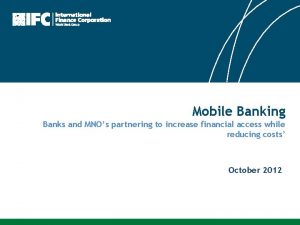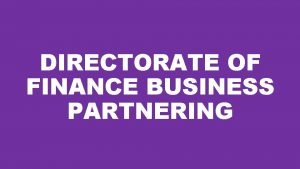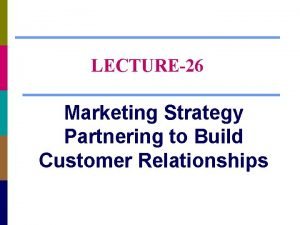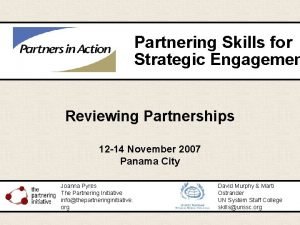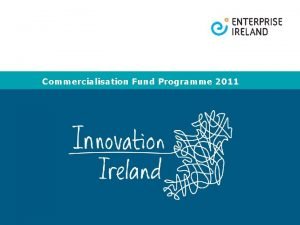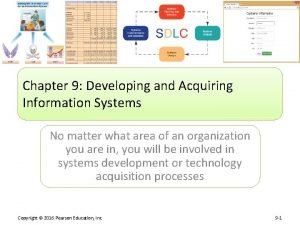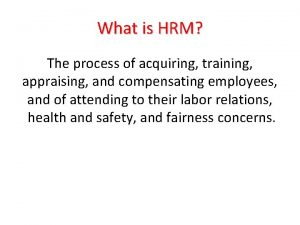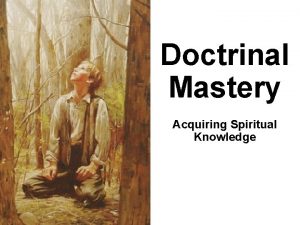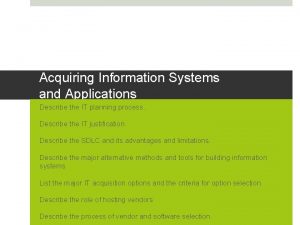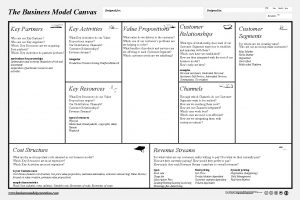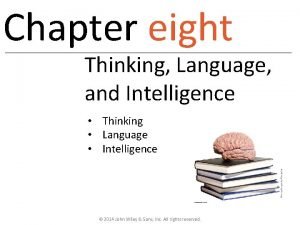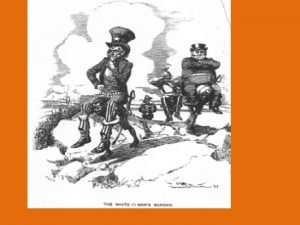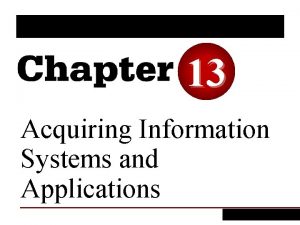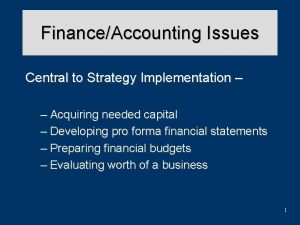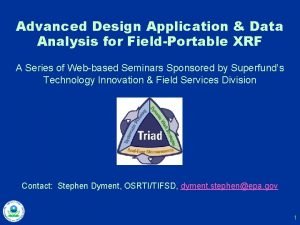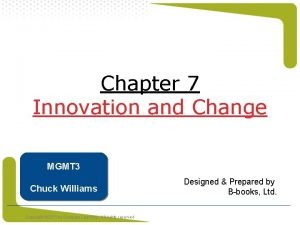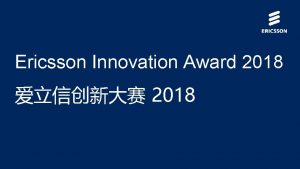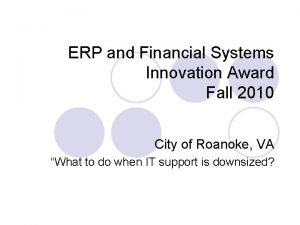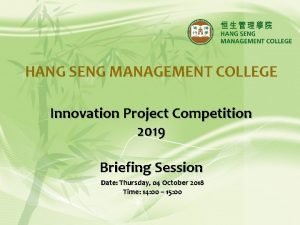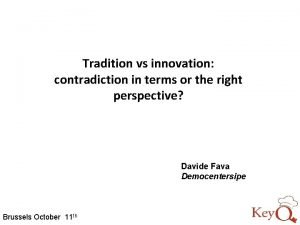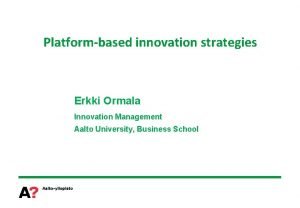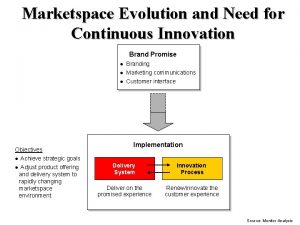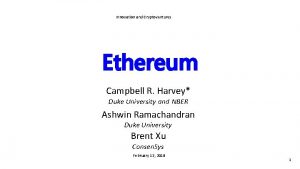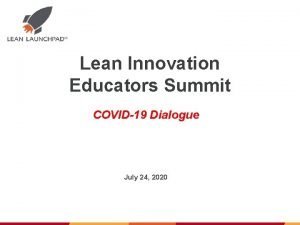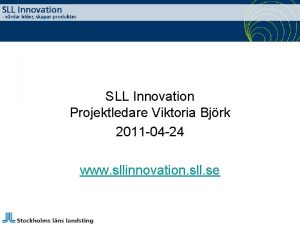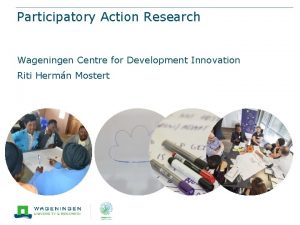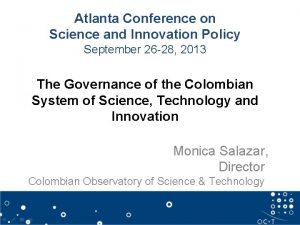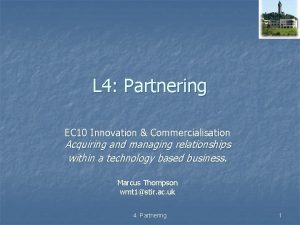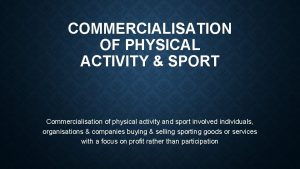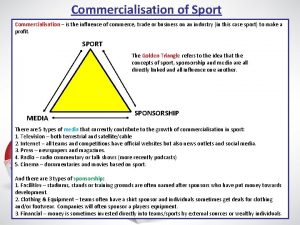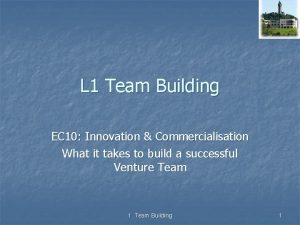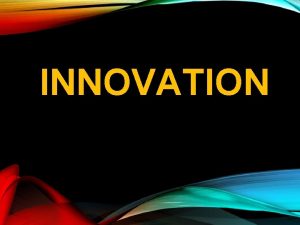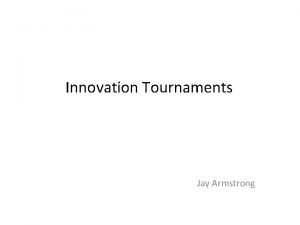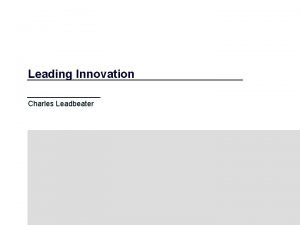L 4 Partnering EC 10 Innovation Commercialisation Acquiring
























































- Slides: 56

L 4: Partnering EC 10 Innovation & Commercialisation Acquiring and managing relationships within a technology based business. Marcus Thompson wmt 1@stir. ac. uk 4. Partnering 1

Partnering Outline n Screening the Idea n Licensing & Joint Ventures n Technology Transfer n Exit Routes 4. Partnering. L 1: Team Building 2

1. Screening The Idea Finding the Idea 4. Partnering

Opportunities & Ideas "An opportunity has the qualities of being attractive, durable, and timely and is anchored in a product or service which creates or adds value for a buyer or and user" (Timmons 1999). "Those situations in which new goods, services, raw materials and organising methods can he introduced and sold at greater than their cost of production " (Casson 1982). An idea which may be a "Plan formed in the mind by thinking" (Oxford dictionary 1981) 4. Partnering 4

Entrepreneurs & Inventors Finding or spotting a viable business ideas is as much an art, or matter of luck, as the use of systematic techniques. the starting point for developing new business ideas lies inside the prospective entrepreneur rather than in the marketplace, laboratory, business plan inventors and innovators do not necessarily make good business people. 4. Partnering 5

Idea generation Most of the worlds most successful entrepreneurs do not have a EUREKA moment. They grasp concepts and deliver them to customers in a more profitable way than others. They find customers who are unfulfilled. – – Cheaper ways of making or selling existing products. Delivering an existing product in a new way. Identifying an unfulfilled market niche, or local market. Inventing a new product that people need. 4. Partnering 6

Idea generation Observations: – Necessity is the mother of invention. – Learn how businesses operate – work in them first. – Learn from other successful people or experts. – Learn about products from all over the world. – Consider markets where products do not exist. – Very few will invent and patent; don’t be precious. – Always challenge assumptions and status quo. 4. Partnering 7

Putting A different Light on Things The idea of a lighted flower pot may strike us as pretty humorous, but it was the answer to a lifelong struggle for a Russian immigrant named Conrad Hubert came to the United States in 1890 when he was about 35 years old. He was flat broke. He did what he could to earn a living. He worked in a cigar store, ran a restaurant for a while and managed a boarding house. He even tried fanning and repairing watches. Whatever he did, however, he never made much money. All he wanted was to stop worrying about making ends meet. Now Hubert had a friend named Joshua Lionel Cowen who was very interested in electricity. Joshua had invented a flower pot with a battery in it. Electricity from the battery made the flower "light up" when a button was pressed. Hubert decided he would try to sell these flower pots. Meanwhile, Joshua became interested in something new, electric trains and he sold his friend the flower pot idea for almost nothing. Fortunately, Hubert never went ahead with the flower pots because he had an idea for a modification. He took the battery, the bulb and the paper tube from the pot and remade it into what he called "an electric hand torch. " Hubert sold his invention at first as a novelty, but the usefulness of the flashlight soon became apparent. When he died in 1928 it must have seemed to Hubert a long time ago that he was poor. He was worth $8, 000. 4. Partnering 8

Six Stages to Evaluating an Idea The Audit The strategic audit addresses where are you are now and where are you going. It deals with ways to build on your (internal) strengths while minimising your weaknesses and also identifies the opportunities and converts threats that your business faces. From the audit a set of objectives is defined which guides the growth and direction that the business is to take. An Audit may raise uncomfortable issues but it will also address how to overcome barriers to growth of which you may not (yet) be aware! Customer Survey The next stage is a Customers Survey to find out what potential customers really think of your idea and what else they would like. It is always a mistake to assume they you already know about your customer wants and needs. If questions are asked, interesting opportunities arise! The trick is to know how to choose and how to ask customers the right questions. Ask the wrong question you get the wrong answer and this leads to the wrong conclusion! 4. Partnering 9

The Six Stages Repositioning – Once information has been gathered it is analysed and the results are used to reposition the business in terms of its customers and the competition. Our approach, which can include existing and potential customers, will allow you to “segment” customers into groups. Care is taken to develop a method to record, on an on-going basis, customers’ needs and wants. Targeting – The fourth stage is to use all this information to target the different groups of customers with the messages that they want to hear. This means mixing and matching different types of media whilst making sure that a coherent and consistent approach is adopted. Our approach means that there is less wastage because information is targeted and also because there a number of ways the promotions industry uses to keep costs down. The Promotions Strategy will aim to take account of existing promotional material and it will include direct marketing. 4. Partnering 10

Six Stages Delivery The next session concentrates on maximising your resources. Particular attention is made to ensuring that your company develops multi-channel methods to deliver and monitor its services. Market Plan Finally the information is gathered together into a working Marketing Plan. The Plan combines the findings from the audit, customer survey and promotions strategy into a single source for growing the customer base profitably. 4. Partnering 11

Creativity & Conflict One common way managers kill creativity is by assembling homogeneous teams. The lure to do so is great. Homogeneous teams often reach “solutions” more quickly and with less friction along the way. These teams often report high morale, too. But homogeneous teams do little to enhance expertise and creative thinking. Everyone comes to the table with a similar mind-set. They leave with the same”. Amabile, T, “How to Kill Creativity”, HBR, Sept - Oct 1998, pp 77 - 85, 4. Partnering 12

Creative Thinking “But the truth is that the winning strategies are smart, innovative and original, and break the rules, and most times there is someone somewhere who has seen through conventions and traditional assumptions to create a new business idea" Piercy 2002, p 269 4. Partnering 13

2. Licensing & Joint Ventures Building an International Network 4. Partnering 14

Uncertainty in Technology Environments Technological uncertainty Sources of Uncertainty Market uncertainty Selection process for standards and dominant designs emerge is complex and difficult to predict, e. g. future of 3 G Customer acceptance and adoption rates of innovations notoriously difficult to predict, e. g. centrino, i-pod, Wi-fi, video conferencing 4. Partnering 15

Risk in Technology Environments Cooperating with lead users early identification of customer requirements –assistance in new product development Strategies For Managing Risk Flexibility Limiting risk exposure —avoid major capital commitments (e. g. lease don’t buy) —outsource —alliances to access other firms’ resources & capabilities —keep debt low —use speed of response to adapt quickly to new information —learn from mistakes 4. Partnering 16

To Lead or to Follow u Is innovation appropriable and protectable against imitation? – If so, advantages in leadership. u Is owning/ controlling industry standard critical to competitive advantage? – If so, advantage in being a leader. u The role of complementary resources. – Followers may be able to avoid investing in complementary resources due to better - established industry infrastructure. – Firms possessing portfolio/resources have the luxury of waiting. 4. Partnering 17

The Profitability of Innovation Legal protection/IPR. Expected Return on Investment Value set against cost structure Organisational resources. Imitability of the technology. Turbulence/Churn. Ability to communicate the value of the innovation to target customers. 4. Partnering Global Drivers. Window of Opportunity. Time to Market. Endorsements. 18

Assessing Emerging Opportunities Process is interactive – each cycle refines the opportunity Information Market Characteristics Product Characteristics Buyer Characteristics Synthesis Analysis Refine Critical relationships Key Success Factors Wickham, Strategic Marketing, Pitman, p 158, 1998 4. Partnering New Opportunity 19

Uppusala Model u A sequential process of functional migration based on a firm’s ‘. . Gradual acquisition, integration & use of knowledge about foreign markets & operations, and on its successively increasing commitment to foreign markets. . ’. . Its about learning. . To overcome ‘psychic distance’. . Over time, firms enter foreign markets with greater psychic distance 4. Partnering 20

Networks & Collaborations u Firms not seen as bounded legal entities u Instead as a complex set of ‘exchange relationships’ within & outwith the firm 4. Partnering 21

Networks & Collaborations… u Existing used to: relationships are resources – develop exchange relationships with ‘actors’ in new networks – to make the firm’s own resources interdependent with resources of firms in other networks or areas – Internationalization develops from the co-operative development of new exchange relationships 4. Partnering 22

Drivers for Internationalisation Product Scope Geographic Scope NARROW BROAD Restricted National Market Narrow Niche Strategy National Broadbased Strategy International Niche Strategy International Broad-based Strategy 4. Partnering 23

Need for Globalization in Production Bartlett & Goshal’s Identification of Needs model Need for National Responsiveness in Selling LOW HIGH Globalization Strategy Mixed Strategy: LOW Mixed Strategy: International Standardization 4. Partnering think global; act local National Responsiveness Strategy 24

Foreign Direct Investment (FDI) u Greatest Control (supposedly) u Greatest Direct Investment Cost u Massive local knowledge requirement u Greenfield & Acquisition alternatives 4. Partnering 25

Joint Ventures u Control achieved through joint ownership (supposedly) u Variable Direct Investment Cost u Local knowledge requirement can be lessened (depending on partner) u Many alternatives of structure/ organization possible 4. Partnering 26

Contractual Agreements u Some Control retained, according to contract u Low or negative cost possible u Can avoid local knowledge need u Many alternatives of structure/ organization possible 4. Partnering 27

Licensing / Franchising u Some Control retained, according to contract u Low or negative cost possible u Can avoid local knowledge need u Many alternatives of structure/ organization possible 4. Partnering 28

Exporting through Distributors / Agents u. Little Control retained u. Low cost, low reward u. Explicitly avoids local knowledge need 4. Partnering 29

3. Technology Transfer Sources of Innovation and their diffusion from pure science to commercial product 4. Partnering 30

Technology Perspectives § Technology Innovations – exploitation of new ideas – incorporating new technologies, design and best practice is the key business. § Commercial Innovation – Venture management strategies and structures that bring these new technologies to market. 4. Partnering 31

Commercial Innovation § Commercial Innovation is about doing things new or different (from your competitors). § It is a management process that centres on being creative & visionary. § It presents itself as the ability to filter and then commercialise. § It applies to: – – – new products new business practices new market applications § These are the skills of the entrepreneur. Are they the skills of the scientist? 4. Partnering 32

Innovation Triggers § Push Innovation. – Where an organisation is already active in a market and needs to maintain competitive advantage. Here the innovator can be a prisoner to their own R&D Success. Ideally this form should be continuous. Downside - can be product-centred organisation. Upside is that it is sustainable model. § Pull innovation. – Where an emerging technology allows innovations to exceed what a customer thought was possible. These are quantum scientific leaps. These are the real scientific innovations. These are disruptive innovations. – Downside - the pull innovation is discontinuous and extremely risky. Discontinuous innovation can also be a one product wonder. SME’s or Corporates? ? § This is where the venture management skills comes in. 4. Partnering 33

Measuring Innovations § Distinctiveness – A distinctive innovation rewrites the rules. § How is this innovation distinct from other ideas that have historically emerged? § Is it the first of its kind in any form? § Is it the first successful implementation? § Companies should also ask questions that help us understand if the “rules of the game” really have been rewritten: § Does your innovation make others react to what you have created and now offer? § Are others forced to make changes based on your actions? § Does this innovation change the basis of competition? Chen, E, Kai-ling Ho, 2001 4. Partnering 34

Measuring Innovation § Impact – Impact differentiates the innovations from the mere inventions. § Is a company only dealing with primary impact? Or is it also valuing the effects of the innovation beyond the scope of its primary customers and achieving secondary impact? § Is a company evaluating measurable impact today as well as the future potential impact? 4. Partnering 35

Technology Transfer § Tech transfer is the flavour of the decade: – EU White Paper on Growth Competitiveness and Employment – EU Green Paper on Innovation – DTI Competitiveness White Paper – HEFCE Reviews of University-Industry Linkages – Lambert Review – Regional initiatives – Po. C, RSE Fellowships – ‘Entrepreneurship’ initiatives – EHE, Science Enterprise Challenge – The ‘third income stream’ debate 4. Partnering 36

Non Conformity § New and small firms are not a homogeneous group with equal enthusiasm, ability, resources or inclination to grow. § Whilst new and small firm sector in aggregate continues to make a significant contribution to the total employment pool, the aggregate data masks a highly skewed distribution. § Whilst most firms employ a few people, only a few provide significant employment. 4. Partnering 37

Industry Collaboration § All focus on closer links (both actual and desired) between universities, industry and government, and all essentially predicated on a view that increased UIC is a ‘good thing’ 4. Partnering 38

UNIVERSITIES & Technology? l Calls to reinterpret the role of the university as a: Hotbed of entrepreneurship l Locus of economic development l Agent of regional transformation l 4. Partnering 39

SEN Policy Towards Academics § “If you are an academic, or academic researcher, working in one of Scotland's higher education institutions, NHS trusts or research establishments, Scottish Enterprise can help you to bring your work to the marketplace. – Proof of Concept Programme funding to early-stage ideas that have typically reached patent level, and could lead to the creation of new businesses, or the licensing of innovative technologies. – Enterprise Fellowship programme, funded by Scottish Enterprise and delivered by the Royal Society of Edinburgh, helps individual academic researchers to develop spin-out companies. – The University of Edinburgh Stanford University link aims to help establish Scotland as a global leader in the commercial development of language technology. – Kelvin Institute aims to transform the ground-breaking research taking place in participating universities today into high-value, commercial, innovative solutions, delivering substantial benefits to everyone involved. – These initiatives are a part of Scottish Enterprise's commitment to increase the flow of good ideas from the research base into Scottish industry and commerce. – We also part fund Technology Ventures Scotland which was set up to provide a strategic and overarching role in encouraging the commercialisation of Scotland's Science and Technology base. ” http: //www. scottish-enterprise. com/sedotcom_home/sig/academics. htm 4. Partnering 40

University Technology Issues § Three issues – The technology transfer process § What is it and what drives it? – The spin-out company process § Organising early stage technology development – The entrepreneurial curriculum § Rethinking the basis for learning in universities? 4. Partnering 41

Technology transfer agenda § Focus on commercialisation of scientific and technical knowledge – Instrumental – ‘tax dollars have paid for this’ – Principled – ‘we ought to make an economic contribution (or, ‘save the planet’)’ – Utilitarian – ‘we need a return on expenditure on research’ 4. Partnering 42

FORMS OF COMMERCIALISATION § Commercialisation and technology transfer takes many forms: – Licensing technology – Spinout company formation – Collaborative research and TT projects – Faculty/student/industry exchange and internship programs – Consultancy/applied research – Teaching, education and outreach programs 4. Partnering 43

WHY TECH TRANSFER? § Funding (especially to replace reduced government core funding) § access to new ideas and techniques § improved contribution to economic needs of region § broaden researchers’ experience § improve quality of research: firms as ‘efficient testing instruments’ 4. Partnering 44

THE BARRIERS TO TT § § § § Lack of internal resources - individual staff Lack of internal resources - institutional RAE and the ‘publish or perish’ culture Lack of academic recognition for collaborative activities Culture gap: researchers vs industrialists Priority conflict: publish vs protect IPR Attitude of business (SMEs especially) - ivory tower stereotype 4. Partnering 45

INDUSTRIAL PARTNERS § Lack of commercial awareness (markets, timescales) by academics § Short-term problem solving emphasis by industry (tech transfer is not always ‘leading edge’) § ‘Culture shock’ in terms of university timescales and project management § Mismatch between absorptive capacity of local industry and the knowledge/technology available for transfer 4. Partnering 46

IMPLICATIONS § Most effective forms of technology transfer are consulting and contract research - improved efficiency of collaboration § Need for improved ‘marketing’ of tech transfer activities and support internally and externally § Review ‘reward and recognition’ for involvement in tech transfer 4. Partnering 47

4. Exit Routes 4. Partnering 48

Conflicts & Power within a Channel § Traditional Channel Management is about dominance. § Stern and E 1 Ansary (1988): § Power is the ability of one channel member to get another channel member to do what the latter would not otherwise have done. Power is the inverse of dependence: the more highly dependent one channel member is on another, the more power the latter has relative to the former. § New paradigm – Trade Marketing = win-win 4. Partnering § Partnering 49

§ TM as a common effort by suppliers and retailers to optimize relations and harmonize resources so as to better serve the consumer and/or try and achieve mutual economies of scale. . . It is a question of the supplier considering the retailer as a customer, with all that involves. The retailer is no longer a mere subcontractor, he has become a partner – and more than a partner, he has become a customer and should be treated as such. Marc Dupuis and Elisabeth Tissier-Desbordes, (1996) Trade marketing and retailing: a European approach, , ESCP, Paris Graduate School of Management, 79 av. de la R~publique, 75011 Paris, France. 4. Partnering 50

Supply Chain Management § an emphasis on joint reduction in channel inventories; § a focus on channel-wide cost efficiencies; § a long-term horizon; § a information sharing as required for planning and monitoring processes; § an emphasis on speed of inventory operations and information; 4. Partnering 51

Alternatives for Exploiting Innovation Licensing Risk & Return small investment risk, but small returns also limited (unless patent position strong) Some legal risks Limits capital investment, but may create dependence on supplies/partner s Few Permits accessing of outside resources and capabilities Konica licensing its digital camera to Hewlett Packard Pixar’s computer animated movies (e. g. “Toy Story”) marketed and distributed by Disney Co. Competing Resources Examples Outsourcing certain functions Strategic Alliance Joint Venture Internal Commercialisation Benefits of flexibility, risks of informal structure Shares investment and risk. Risk of partner disagreement and culture clash Biggest investment requirement and corresponding risks. Benefits of control Permits pooling of the resources and capabilities of more than one firm Apple and Sharp build the “Newton” PDA 4. Partnering Substantial requirements in terms of finance, production capability, marketing capability, distribution, etc. Microsoft and TI divestment of NBC formed its Digital Signal MSNBC Processing Chips 52

Route Adopted Directorship Form a management team, raise finance and launch. Licensing Level of Control Commercial arrangement through which licensor of IPR allows licensee to develop sell or use in return for a royalty payment. Assignation Sell rights and transfer the ownership of the invention and IPR to third party for lump sum. Joint Venture & Partnerships Collaboration with one or more organisations to exploit IPR. Includes sharing of costs and revenues. 4. Partnering 53

To Lead or to Follow § Is innovation appropriable and protectable against imitation? § If so, advantages in leadership. § Is owning/ controlling industry standard critical to competitive advantage? § If so, advantage in being a leader. § The role of complementary resources. § Followers may be able to avoid investing in complementary resources due to betterestablished industry infrastructure. § Firms possessing portfolio/resources have the luxury of waiting. 4. Partnering 54

Assessing Emerging Opportunities Process is interactive – each cycle refines the opportunity Information Market Characteristics Product Characteristics Buyer Characteristics Synthesis Analysis Refine Critical relationships Key Success Factors Wickham, Strategic Marketing, Pitman, p 158, 1998 4. Partnering New Opportunity 55

Going to Market Value Definition Analytical Behavioural Information Interpreting Understanding Organisational Learning Value Development Operations Motivation Responsiveness Value Delivery Logistics/ Supply Chain Attitudes Behaviour Reinvention Process of Going to Market Customer Value 4. Partnering 56
 Mnos partnering
Mnos partnering Finance business partnering definition
Finance business partnering definition Partnering to build customer relationships
Partnering to build customer relationships What is partnering
What is partnering The partnering initiative
The partnering initiative Partnering session
Partnering session Mysite socccd
Mysite socccd Radical vs disruptive innovation
Radical vs disruptive innovation Commercialisation in sport definition
Commercialisation in sport definition Ei commercialisation fund
Ei commercialisation fund Commercialisation triangle
Commercialisation triangle Advantages and disadvantages of commercialisation in sport
Advantages and disadvantages of commercialisation in sport Acquiring information examples
Acquiring information examples Methods of acquiring information system
Methods of acquiring information system Canvas key partners
Canvas key partners Learning means acquiring knowledge
Learning means acquiring knowledge Acquiring information systems and applications
Acquiring information systems and applications Acquiring new lands section 3
Acquiring new lands section 3 Process of acquiring training appraising and compensating
Process of acquiring training appraising and compensating Acquiring spiritual knowledge part 1
Acquiring spiritual knowledge part 1 Acquiring the reflectance field of a human face
Acquiring the reflectance field of a human face Aquiring spiritual knowledge
Aquiring spiritual knowledge Methods of acquiring information
Methods of acquiring information Business model canvas example
Business model canvas example Chapter 8 thinking language and intelligence
Chapter 8 thinking language and intelligence Examining questions with an eternal perspective
Examining questions with an eternal perspective What factors did you consider in acquiring territories?
What factors did you consider in acquiring territories? Acquiring information systems and applications
Acquiring information systems and applications What are the different methods of acquiring knowledge
What are the different methods of acquiring knowledge Acquiring capital to implement strategies
Acquiring capital to implement strategies Partial schedule of reinforcement
Partial schedule of reinforcement Means acquiring goods and or services
Means acquiring goods and or services Chapter 10 section 3 acquiring new lands
Chapter 10 section 3 acquiring new lands Innovation field
Innovation field Compression approach to innovation
Compression approach to innovation Scientific and technical innovation global context
Scientific and technical innovation global context Ericsson innovation awards 2018
Ericsson innovation awards 2018 The importance of technology
The importance of technology Erp innovation awards
Erp innovation awards Innovation seng
Innovation seng Tradition and innovation quotes
Tradition and innovation quotes Rasberry
Rasberry Continuous innovation loop
Continuous innovation loop Innovation matrix template
Innovation matrix template Innovation and invention
Innovation and invention Innovation and cryptoventures
Innovation and cryptoventures White space innovation
White space innovation District of innovation pros and cons
District of innovation pros and cons Openflow: enabling innovation in campus networks
Openflow: enabling innovation in campus networks Sap innovation awards 2019
Sap innovation awards 2019 New market innovation examples
New market innovation examples Lean innovation educators summit
Lean innovation educators summit Sll innovation
Sll innovation Wageningen centre for development innovation
Wageningen centre for development innovation Innovative change definition
Innovative change definition Atlanta conference on science and innovation policy
Atlanta conference on science and innovation policy Trimech innovation inevitable
Trimech innovation inevitable
